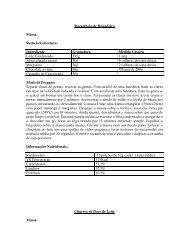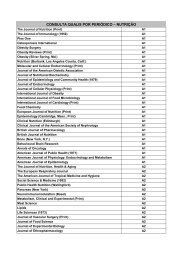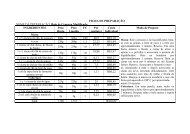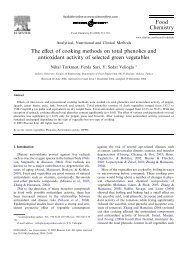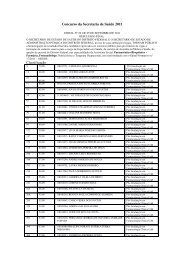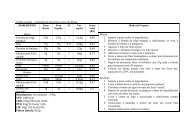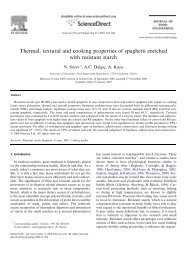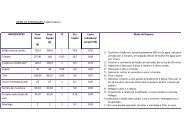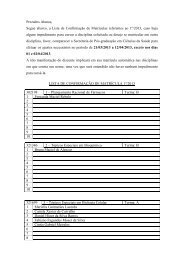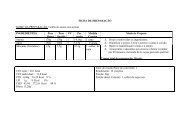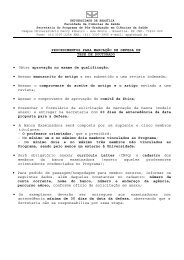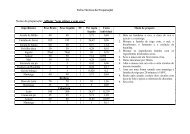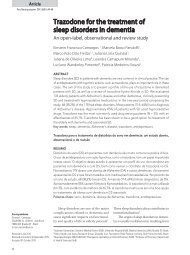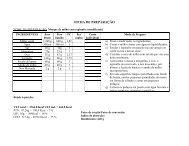Texture is a sensory property
Texture is a sensory property
Texture is a sensory property
Create successful ePaper yourself
Turn your PDF publications into a flip-book with our unique Google optimized e-Paper software.
Food Quality and Preference 13(2002) 215–225<br />
www.elsevier.com/locate/foodqual<br />
<strong>Texture</strong> <strong>is</strong> a <strong>sensory</strong> <strong>property</strong><br />
Alina Surmacka Szczesniak*<br />
22 Wilson Block, Mount Vernon, NY 10552-1113, USA<br />
Received 15 July 2000; received in rev<strong>is</strong>ed form 3February 2001; accepted 12 March 2001<br />
Abstract<br />
Realizing that texture <strong>is</strong> a <strong>sensory</strong> <strong>property</strong> gives proper orientation to facets of texture research. Following the breakthrough in<br />
the 1960s and 1970s in surfacing the multi-parameter nature of texture and in defining the general principles of texture acceptability,<br />
the field has essentially reverted to commodity work. Th<strong>is</strong> paper reviews briefly the state of knowledge and points out specific<br />
research areas that could constitute new significant breakthroughs. These include defining the components of complex textural<br />
character<strong>is</strong>tics, developing an understanding of the perceptual interplay among texture parameters and between textural and other<br />
(e.g. v<strong>is</strong>ual clues, taste) modalities, exploring the breakdown pathways in the mouth for various food categories, and repeating<br />
earlier studies on consumer attitudes and preferences in the context of 21st century cultures and lifestyles. # 2002 Elsevier Science<br />
Ltd. All rights reserved.<br />
Keywords: <strong>Texture</strong>; Parameters; Perception; Consumer acceptance; Research needs<br />
1. Introduction<br />
Work on texture dates back to the late 19th and early<br />
20th centuries (Bourne, 1982). It involved construction<br />
of simple testing instruments to be followed by biochemical<br />
analytical research and some rudimentary<br />
<strong>sensory</strong> evaluations. It was concerned primarily with the<br />
elimination of defects. Bread, meat and horticultural<br />
products of economic significance, fruits (such as apples<br />
and peaches) and vegetables (primarily corn and sweet<br />
peas) received the greatest attention.<br />
In the early days research on texture was commodity<br />
oriented with no or little interaction among product<br />
groups. As a result, there was much confusion even on<br />
the definition of texture since each group had its own.<br />
Some equated texture with structure, others with tenderness,<br />
toughness, cr<strong>is</strong>pness, terms which were poorly<br />
defined and had different meaning to researchers dealing<br />
with different products.<br />
It was not until the late 1950s that texture began to be<br />
looked at as a subject in itself (the way flavor had been<br />
studied for some time) mainly owing to a group of forward<br />
thinking technical research managers at the General<br />
Foods Corporation in the USA.<br />
* Tel. +1-914-668-7365.<br />
E-mail address: alinasz@aol.com (A.S. Szczesniak).<br />
Today, the field has some structure, some principles<br />
have been developed and — above all — texture <strong>is</strong> being<br />
looked at not so much as the absence of defects, but as a<br />
positive quality attribute denoting freshness of produce,<br />
excellence of food preparation and contributing to the<br />
enjoyment of eating.<br />
2. Definition of texture<br />
A general agreement has been reached on the definition<br />
of texture which evolved from the efforts of a<br />
number of researchers. It states that ‘‘texture <strong>is</strong> the <strong>sensory</strong><br />
and functional manifestation of the structural,<br />
mechanical and surface properties of foods detected<br />
through the senses of v<strong>is</strong>ion, hearing, touch and kinesthetics’’.<br />
Th<strong>is</strong> definition conveys important concepts<br />
such as:<br />
1. texture <strong>is</strong> a <strong>sensory</strong> <strong>property</strong> and, thus, only a<br />
human being (or an animal in the case of animal<br />
food) can perceive and describe it. The so-called<br />
texture testing instruments can detect and quantify<br />
only certain physical parameters which then must<br />
be interpreted in terms of <strong>sensory</strong> perception;<br />
2. it <strong>is</strong> a multi-parameter attribute, not just tenderness<br />
or chewiness, but a gamut of character<strong>is</strong>tics;<br />
0950-3293/02/$ - see front matter # 2002 Elsevier Science Ltd. All rights reserved.<br />
PII: S0950-3293(01)00039-8
216 A.S. Szczesniak / Food Quality and Preference 13 (2002) 215–225<br />
3. it derives from the structure of the food (molecular,<br />
microscopic or macroscopic); and<br />
4. it <strong>is</strong> detected by several senses, the most important<br />
ones being the senses of touch and pressure.<br />
3. <strong>Texture</strong> profiling<br />
Table 1<br />
Classification of textural character<strong>is</strong>tics a<br />
Mechanical character<strong>is</strong>tics<br />
Primary parameters<br />
Secondary<br />
parameters<br />
Popular terms<br />
Hardness<br />
Soft ! Firm ! Hard<br />
Cohesiveness Brittleness Crumbly ! Crunchy<br />
! Brittle<br />
Chewiness Tender ! Chewy !Tough<br />
Gumminess Short ! Mealy<br />
! Pasty Gummy<br />
V<strong>is</strong>cosity<br />
Thin ! V<strong>is</strong>cous<br />
Springiness<br />
Plastic ! Elastic<br />
Adhesiveness<br />
Sticky ! Tacky Gooey<br />
Geometrical character<strong>is</strong>tics<br />
Class<br />
Particle size and shape<br />
Particle shape and<br />
orientation<br />
Other character<strong>is</strong>tics<br />
Primary parameters<br />
Secondary<br />
parameters<br />
Examples<br />
Gritty, Grainy, Coarse, etc.<br />
Fibrous, Cellular,<br />
Crystalline, etc.<br />
Popular terms<br />
Mo<strong>is</strong>ture content<br />
Dry ! Mo<strong>is</strong>t ! Wet<br />
! Watery<br />
Fat content Oiliness Oily<br />
Greasiness Greasy<br />
a Szczesniak, 1963by perm<strong>is</strong>sion of the Institute of Food<br />
Technolog<strong>is</strong>ts.<br />
Since texture <strong>is</strong> a multi-parameter attribute, as evidenced<br />
by a large number of words used to describe it, it<br />
<strong>is</strong> only logical to try to introduce some order and classify<br />
these terms’ sensations into certain categories. An<br />
attempt at doing th<strong>is</strong> <strong>is</strong> shown in Tables 1 and 2 for solids<br />
and semi-solids (Civille & Szczesniak, 1973; Szczesniak,<br />
1963) and Table 3 for liquids (Szczesniak, 1979).<br />
The classification of textural terms for solids and<br />
semi-solids gave r<strong>is</strong>e to a profiling method of texture<br />
description (TPA) applicable to both <strong>sensory</strong> (Brandt,<br />
Skinner, & Coleman, 1963) and instrumental measurements<br />
(Bourne, 1978; Szczesniak, Brandt, & Friedman,<br />
1963a). With the <strong>sensory</strong> method the evaluation<br />
includes (Fig. 1) several steps outside and inside the<br />
mouth, from the first bite through mastication, swallowing<br />
and residual feel in the mouth and throat. Its use<br />
<strong>is</strong> based on standard scales for the mechanical parameters<br />
(Szczesniak et al., 1963a) which are also<br />
employed for selecting and training of panel members<br />
(Civille & Szczesniak, 1973). As an illustration, Table 4<br />
shows the original standard scale for hardness (Szczesniak<br />
et al., 1963a). The scale covers the entire range of<br />
hardness found in food products, from cream cheese at<br />
the low end to rock candy at the high end. It was<br />
recommended that when testing specific products the<br />
scale should be expanded in the intensity range covered<br />
by the test products. Experience gained in subsequent<br />
practical applications of these scales led to some modifications<br />
and development of additional scales described<br />
in a publication by Munoz (1986).<br />
With the instrumental method, texture profiling<br />
involves compressing the test substance at least twice and<br />
quantifying the mechanical parameters from the recorded<br />
force-deformation curves (Fig. 2). With temperature<br />
sensitive foods, e.g. gelatin gels or chocolate, the profiling<br />
should be extended to temperature and tests performed<br />
at several temperature levels (Szczesniak, 1975a).<br />
Excellent correlations between instrumental and <strong>sensory</strong><br />
ratings were found in the initial work on TPA<br />
(Fig. 3). Subsequent publications by other researchers<br />
using the Instron (rather than the General Foods Texturometer<br />
exhibiting a sinusoidal manner of force<br />
application) generally agree on good to excellent correlations<br />
for hardness (based on calculated ‘r’ values).<br />
Correlations for other parameters are usually less good<br />
and product-dependent. Th<strong>is</strong> area should be re-examined<br />
using comprehensive, rather than product-specific,<br />
research protocols.<br />
4. Complexity of textural parameters<br />
Some <strong>sensory</strong> parameters, especially the mechanical<br />
ones, seem to be fairly straight forward. For example,<br />
hardness/firmness/softness are on a scale of res<strong>is</strong>tance of<br />
the food to the applied compressive forces. However, it<br />
<strong>is</strong> still not known exactly whether the human being<br />
reacts to the physical stress or to the strain, and how to<br />
simulate with instruments the high strain rates experienced<br />
in the mouth, a consideration very important with<br />
v<strong>is</strong>coelastic materials (i.e. most food products). Also<br />
importantly, we do not know where on the instrumental<br />
scale the boundaries are between hard and firm, and<br />
firm and soft.<br />
Some other <strong>sensory</strong> parameters, e.g. creaminess and<br />
juiciness, may not be so straight forward. Work by several<br />
researchers on defining creaminess related it to<br />
thickness (which depends on physical v<strong>is</strong>cosity) and<br />
smoothness (which depends on physical frictional forces)<br />
(Guinard & Mazzucchelli, 1996).<br />
Juciness was h<strong>is</strong>torically equated with the amount of<br />
juice released on mastication and quantified objectively<br />
as such. Then, a second dimension — rate of juice
A.S. Szczesniak / Food Quality and Preference 13 (2002) 215–225 217<br />
release on sequential chews — was added while studying<br />
strawberries (Szczesniak & Smith, 1969) and meat<br />
(Szczesniak, Sloman, Brandt & Skinner, 1963b) processed<br />
in ways that altered their water holding capacity. A<br />
detailed evaluation of a variety of foods of plant origin by<br />
an analytical panel suggested that at least five perceptions<br />
may be combined in the human brain to form an opinion<br />
about juiciness of a food product. These are:<br />
Table 2<br />
Definitions of mechanical parameters of texture a<br />
Physical<br />
Sensory<br />
Primary properties<br />
Hardness Force necessary to attain a given dformation Force required to compress a substance between molar<br />
teeth (in the case of solids) or between tongue and palate<br />
(in the case of semi-solids).<br />
Cohesiveness<br />
Extent to which a material can be deformed<br />
before it ruptures.<br />
Degree to which a substance <strong>is</strong> compressed between the<br />
teeth before it breaks.<br />
V<strong>is</strong>cosity Rate of flow per unit force. Force required to draw a liquid from a spoon over the tongue.<br />
Springiness<br />
Adhesiveness<br />
Secondary properties<br />
Fracturability<br />
Rate at which a deformed material goes back<br />
to its undeformed condition after the<br />
deforming force <strong>is</strong> removed<br />
Work necessary to overcome the attractive<br />
forces between the surface of the food and<br />
the surface of the other materials with which<br />
the food comes in contact.<br />
Force with which a material fractures: a<br />
product of high degree of hardness and<br />
low degree of cohesiveness.<br />
Degree to which a product returns to its original shape<br />
ond=ce it has been co,pressed between the teeth<br />
Force required to remove the material that adheres to the mouth<br />
(generally the palate) during the normal eating process.<br />
Force with which a sample crumbles, cracks, or shatters.<br />
Chewiness<br />
Gumminess<br />
Energy required to masticate a solid food to<br />
a state ready for swallowing: a product of<br />
hardness, cohesiveness and springiness<br />
Energy required to d<strong>is</strong>integrate a semi-solid<br />
food to a state ready for swallowing: a<br />
product of a low degree of hardness and a<br />
high degree of cohesiveness.<br />
Length of time (in sec) required to masticate the sample, at a<br />
constant rate of force application, to reduce it to a cons<strong>is</strong>tency<br />
suitable for swallowing.<br />
Denseness that pers<strong>is</strong>ts throughout mastication; energy required<br />
to d<strong>is</strong>integrate a semi-solid food to a state ready for swallowing.<br />
a Civille and Szczesniak, 1973. By perm<strong>is</strong>sion of the Food and Nutrition Press, Inc.<br />
Table 3<br />
Classification of mouthfeel terms a Category Typical words<br />
I V<strong>is</strong>cosity-related terms Thin, thick, v<strong>is</strong>cous<br />
II Feel on soft t<strong>is</strong>sue Smooth, pulpy, creamy<br />
surfaces<br />
III Carbonation-related Bubbly, tingly, foamy<br />
terms<br />
IV Body-related terms Heavy, watery, light<br />
V Chemical effect Astringent, burning, sharp<br />
VI Coating of oral cavity Mouthcoating, clinging,<br />
Fatty, oily<br />
VII Res<strong>is</strong>tance to tongue Slimy, syrupy, pasty,<br />
movement<br />
Sticky<br />
VIII Afterfeel-mouth Clean, drying, lingering, cleansing<br />
IX Afterfeel-physiological Refreshing, warming, thirst-quenching, filling<br />
X Temperature-related Cold, hot<br />
XI Wetness-related Wet, dry<br />
a Szczesnik 1979.
218 A.S. Szczesniak / Food Quality and Preference 13 (2002) 215–225<br />
1. force with which the juice squirts out of the product;<br />
2. rate of juice release;<br />
3. total amount released on chewing;<br />
4. flow properties of the expressed fluid;<br />
5. contrast in cons<strong>is</strong>tency between liquid and suspended<br />
cell debr<strong>is</strong>; and<br />
6. effect on saliva production (Szczesniak & Ilker,<br />
1988).<br />
Table 4<br />
Examp1e of a standard scale — Hardness a<br />
Panel rating Product Brand or type Manufacturer Sample size Temperature<br />
1<br />
1 Cream cheese Philadelphia Kraft Foods<br />
2 in. 45–55 F<br />
1<br />
2 Egg white Hard–cooked 5 min –<br />
2<br />
in. tip room<br />
1<br />
3Frankfurters Large, uncooked, skinless Mogen David Kosher Meat Products Corp.<br />
2 in. 50–65 F<br />
1<br />
4 Cheese Yellow, American pasteurized process Kraft Foods<br />
2 in. 50–65 F<br />
5 Olives Exqu<strong>is</strong>ite giant size, stuffed Cresca Co: 1 olive 50–65 F<br />
6 Peanuts Cocktail type in vacuum tin Planters Peanuts 1 nut Room<br />
1<br />
7 Carrots Uncooked, fresh –<br />
2<br />
in. Room<br />
8 Peanut brittle Candy part Kraft Foods – Room<br />
9 Rock candy – Dryden & Palmer – Room<br />
a Szczesniak et al., 1963a By perm<strong>is</strong>sion of the Institute of Food Technolog<strong>is</strong>ts.<br />
Fig. 1. Schematic of the early <strong>sensory</strong> texture profiling technique. Brandt et al., 1963. By perm<strong>is</strong>sion of the Institute of Food Technolog<strong>is</strong>ts.
A.S. Szczesniak / Food Quality and Preference 13 (2002) 215–225 219<br />
5. Perception<br />
5.1. Physiology of the oral cavity<br />
Although some texture assessment <strong>is</strong> performed<br />
v<strong>is</strong>ually, the main evaluation occurs in the mouth. The<br />
anatomy and physiology of the oral cavity has been<br />
studied from the standpoint of general knowledge generation<br />
and its application to medical and dental problems.<br />
It was reviewed and d<strong>is</strong>cussed by several authors<br />
(Boyer & Kilcast, 1986a; Heath, 1991; Kilcast & Eves,<br />
1991; Ledley, 1971; Yeatman & Drake, 1973). However,<br />
because of its complexity the psychophysiology of texture<br />
perception <strong>is</strong> not well known. A comprehensive<br />
review on the subject has been publ<strong>is</strong>hed by Chr<strong>is</strong>tensen<br />
(1984).<br />
In contrast to other <strong>sensory</strong> food attributes (e.g. taste<br />
and color) there are no single and specific receptors for<br />
texture because of its multiparameter nature. Some textural<br />
(geometrical) parameters are felt when the food <strong>is</strong><br />
first placed in the mouth. Most are perceived when the<br />
food <strong>is</strong> deformed on chewing with the teeth, manipulated<br />
and moved by the tongue around the oral cavity,<br />
and mixed with saliva. A number of t<strong>is</strong>sues (e.g. periodontal,<br />
skin, in the temperomandibular joint) and<br />
receptors (somesthetic, kinesthetic) are involved. They<br />
perceive such texture-related sensations as touch/pressure,<br />
pain, joint position, etc. Manly, Pfaffman,<br />
Lathrop, and Keyser et al (1952) postulated that kinesthetic<br />
sensations may be most important for soft foods<br />
and periodontal tactile/pressure sensations for hard<br />
foods. Information reg<strong>is</strong>tered by the receptors <strong>is</strong><br />
instantly carried to the central nervous system and then<br />
to the brain by the trigeminal nerve. It has been suggested<br />
that the v<strong>is</strong>coelastic properties of the periodontal<br />
t<strong>is</strong>sues are important in the detection of forces applied<br />
Fig. 2. Generalized instrumental texture profile curve (obtained with<br />
the General Foods Texturometer).<br />
in mastication (van Steenberghe & de Vries, 1978, quoted<br />
by Chr<strong>is</strong>tensen, 1984).<br />
5.2. Approaches to perception research<br />
Early work on <strong>sensory</strong> perception of textural character<strong>is</strong>tics<br />
used non-edible materials of defined rheological<br />
properties (e.g. Scott Blair & Coppen, 1940). The<br />
same approach was employed by Mioche, Petron, and<br />
Auroy (1973) to study the force of mastication using<br />
miniaturized load cells placed in the oral cavity. These<br />
authors felt that ‘‘the use of load cells together with foodstufffs<br />
models exhibiting simple predictable character<strong>is</strong>tics<br />
opens up new areas of investigation into texture perception<br />
of solid products’’. Another new area was opened<br />
up by Kilcast at the Leatherhead R.S. in England who<br />
utilized electromyography to follow changes in food<br />
res<strong>is</strong>tance on mastication (Boyer & Kilcast, 1986b).<br />
More work <strong>is</strong> needed on how specific textural attributes<br />
are perceived in the mouth and how they are<br />
affected by mouth temperature, rate of mastication and<br />
saliva. A rigorous and analytical approach <strong>is</strong> needed.<br />
Chr<strong>is</strong>tensen (1984) recommended that ‘‘where possible,<br />
indirect measures of perception should be replaced by<br />
direct measures, and correlative studies should be supplemented<br />
with studies that critically test hypothes<strong>is</strong>’’.<br />
To obtain a complete understanding would be a Herculean<br />
task, time consuming, economically, scientifically<br />
and intellectually taxing. A principle taught to officers<br />
in war colleges might be applied here: divide and conquer.<br />
Divide the field into priorities based on the economic<br />
importance of specific textural character<strong>is</strong>tics<br />
combined with the recognition of the dynamic aspects<br />
of texture assessment<br />
5.3. Breakdown path in the mouth<br />
The recognition that texture <strong>is</strong> a multiparameter<br />
attribute <strong>is</strong> reflected in the development of the profiling<br />
methodology for both its <strong>sensory</strong> and instrumental<br />
assessment. The dynamic aspects of texture evaluation<br />
in the mouth, however, are presently considered seriously<br />
only in <strong>sensory</strong> profiling.<br />
During the process of mastication in the mouth the<br />
food <strong>is</strong> broken into small particles through a combination<br />
of compressive, shearing and tensile forces, wetted<br />
and lubricated with saliva, and formed into a bolus suitable<br />
for swallowing. Th<strong>is</strong> dynamic aspect of texture<br />
perception has been treated in a conceptual manner by<br />
Hutchings and Lillford (1988) and also d<strong>is</strong>cussed<br />
recently by Heath and Prinz (1999).<br />
Hutchings and Lillford (1988) presented a hypothes<strong>is</strong><br />
that each food has a character<strong>is</strong>tic ‘‘breakdown path’’ in<br />
the mouth compr<strong>is</strong>ed of three dimensions: structure,<br />
degree of lubrication and time. They postulated that th<strong>is</strong><br />
breakdown path affects consumer preference and may
Fig. 3. Correlations between <strong>sensory</strong> and instrumental values on standard texture scales. Szczesniak et al., 1963. By perm<strong>is</strong>sion of the Institute of Food Technolog<strong>is</strong>ts.<br />
220 A.S. Szczesniak / Food Quality and Preference 13 (2002) 215–225
A.S. Szczesniak / Food Quality and Preference 13 (2002) 215–225 221<br />
be subject to considerable variations. These may<br />
include: individual differences among consumers (slow/<br />
passive eaters vs. fast/nervous eaters), their age (children<br />
vs. adults vs. old people), physiological state (hunger<br />
vs. satiety) and eating occasions (hurried vs.<br />
le<strong>is</strong>urely meals). These authors also provided details of<br />
what should be considered in pursuing the validation of<br />
th<strong>is</strong> hypothes<strong>is</strong> and of the presented model.<br />
Without doubt, the dynamic aspects of texture<br />
assessment should be studied in depth and defined both<br />
qualitatively and quantitatively for various food classes.<br />
Computer imaging and simulation techniques may be<br />
very applicable and helpful here.<br />
5.4. Gestalt<br />
The word ‘Gestalt’ <strong>is</strong> defined in Webster’s dictionary<br />
as ‘‘a structure or configuration of physical, biological<br />
or psychological phenomena so integrated as to constitute<br />
a functional unit with properties not derivable<br />
from its parts in summation’’. When applied to the<br />
study of perception the concept of ‘Gestalt’ rejects atom<strong>is</strong>tic<br />
or elemental analys<strong>is</strong> of the stimulus and implies<br />
an indiv<strong>is</strong>ible connectiveness. It has come to mean (1)<br />
that a word used to denote a perception may actually<br />
refer to the sum of several individual sensations (th<strong>is</strong><br />
has been illustrated earlier on the example of ‘juiciness’),<br />
and (2) that the presence of one stimulus may influence<br />
judgment on the perception of another stimulus (e.g. the<br />
color of a beverage will influence its flavor perception).<br />
The early psychorheolog<strong>is</strong>ts, especially the d<strong>is</strong>tingu<strong>is</strong>hed<br />
father of food rheology Dr. George Scott<br />
Blair and h<strong>is</strong> co-workers, were very cognizant of the<br />
Gestalten in their work that attempted to correlate<br />
physical measurements on cheese and dough with the<br />
expert <strong>sensory</strong> description by experienced cheese makers<br />
and bakers. They concluded that the Gestalten were not<br />
analyzable and defied logic (Scott Blair, 1963). The<br />
psycholog<strong>is</strong>t David Katz, working in the late 1930 0 sin<br />
the breadmaking industry, concluded that the term<br />
‘body’, which was most generally used, was a composite<br />
mixture of four <strong>sensory</strong> properties: (1) the degree of<br />
stickiness; (2) the degree of elasticity in the <strong>sensory</strong> sense<br />
of bounce or springiness; (3) the level of res<strong>is</strong>tance to<br />
tearing; and (4) the extensibility or ductility. Katz has<br />
made two important observations (1) that the nature<br />
and number of <strong>sensory</strong> perceptions may be different<br />
from physical properties, and (2) that the integration of<br />
perceptions <strong>is</strong> subconscious (quoted by Szczesniak,<br />
1990a). No quantitative relationships were developed by<br />
these early researchers because of the tediousness of<br />
calculations and the tremendous time investment<br />
required. Today, the use of computers should make<br />
possible significant advances in th<strong>is</strong> line of research by<br />
enabling the researchers to perform computations in a<br />
manner not possible in the past.<br />
6. Consumer and texture<br />
Comprehensive studies on consumer attitudes to texture<br />
were conducted by the General Foods group and<br />
appeared in the literature in the 1960s and 1970s<br />
(Szczesniak, 1971, 1972; Szczesniak and Kahn, 1971;<br />
Szczesniak and Kleyn, 1963). The researchers combined<br />
their backgrounds in food science, sociology and consumer<br />
testing to develop some general principles<br />
applicable to understanding consumer likes and d<strong>is</strong>likes<br />
and to guiding product development work. The techniques<br />
used were word association and in-depth consumer<br />
interviews. Although it appears that the developed general<br />
principles are still valid today, th<strong>is</strong> type of studies<br />
should be repeated to identify what changes in consumer<br />
thinking about texture might have occurred in<br />
the intervening years due to changing life styles, changing<br />
food habits, greater soph<strong>is</strong>tication of consumers<br />
and greater appreciation by the food industry of the<br />
positive and saleable aspects of texture (Szczesniak,<br />
1990b).<br />
6.1. Factors shaping attitudes to texture<br />
The first important finding in the early studies was<br />
that, for the most part, texture <strong>is</strong> taken for granted and<br />
consumers do not comment on it unless asked specific<br />
questions, or unless texture <strong>is</strong> definitely off or inappropriate,<br />
expectations are violated or non-food associations<br />
are triggered. Th<strong>is</strong> <strong>is</strong> important to remember<br />
when conducting consumer tests. The second key finding<br />
was that texture has quality associations. It <strong>is</strong> indicative<br />
of freshness (limp lettuce, shriveled apples, stale<br />
bread are considered not fresh) and excellence in food<br />
preparation. Some concerns about health effects are also<br />
associated with off textures, although other <strong>sensory</strong><br />
cues, such as odor, are the primary signals of spoiled<br />
food that may be injurious to one’s health when eaten.<br />
Attitudes to texture are shaped by physiological factors,<br />
socially and culturally learned expectations, and<br />
psychological factors (Szczesniak & Kahn, 1971). People<br />
like to be in full control of the food placed in their<br />
mouth. Stringy, gummy or slimy foods or those containing<br />
unexpected lumps or hard particles are rejected<br />
for fear of gagging or choking. Consumers, especially<br />
those in the lower socio-economic classes and especially<br />
women, are very conscious of how they look while eating<br />
and difficult to manipulate textures evoke negative<br />
attitudes. Associations with non-edible objects and with<br />
unpleasant past events will also lead to rejection of certain<br />
textures. Learning about foods <strong>is</strong> a continuing<br />
process and adults — particularly those of higher socioeconomic<br />
status — learn to accept new, exotic, soph<strong>is</strong>ticated<br />
foods at almost any stage of life. The recent<br />
explosion of Oriental foods and restaurants in the USA<br />
<strong>is</strong> an example. In th<strong>is</strong> context, the American consumer
222 A.S. Szczesniak / Food Quality and Preference 13 (2002) 215–225<br />
has learned to consume firm, cr<strong>is</strong>p cooked vegetables<br />
which in the past were expected to be soft and almost<br />
mushy.<br />
The age of the consumer appears to have an influence<br />
on h<strong>is</strong>/her attitude to and appreciation of texture. Past<br />
work (Szczesniak, 1972) indicated that teenagers had a<br />
higher degree of texture awareness. These teenagers are<br />
now adult consumers willing to experiment with and<br />
accept different textures.<br />
6.2. Factors in acceptance<br />
Factors affecting acceptance of texture may be divided<br />
into those residing in the consumers, those residing<br />
in the food, and those residing in the eating situation.<br />
The primary factor associated with the consumer <strong>is</strong><br />
the age, especially the two extremes: babies and young<br />
children, and the geriatric population. The interplay<br />
between texture acceptance and developmental sequence<br />
of oral functions and motor skills has been d<strong>is</strong>cussed by<br />
Szczesniak (1972) based on consumer interviews and the<br />
classical observational study of child development by A.<br />
Gesell and her associates. Babies and young children<br />
reject textures that are difficult to manipulate in the<br />
mouth at a particular stage of physical development.<br />
The baby food industry <strong>is</strong> well aware of the principles<br />
and practices them with great economic success, but<br />
some refinements in terms of texture optimization may<br />
be in order.<br />
The population of industrialized countries <strong>is</strong> ageing<br />
rapidly, with the percentage of people in their 70s and<br />
80s increasing at an especially fast pace. In the USA the<br />
85+ years age group <strong>is</strong> the fastest growing segment of<br />
the population. In 1998 there were more than 62,000<br />
centenarians and, by some estimates, that number could<br />
reach 1 million by the year 2050. In general, older people<br />
are less willing to learn new things and, thus, in<br />
terms of texture acceptance and preference may be very<br />
conservative. Some have trouble chewing either because<br />
of poor dentition, or because of weak muscles and poor<br />
coordination. Problems with swallowing and with ‘dry<br />
mouth’ because of reduced saliva production are common.<br />
The most prevalent swallowing d<strong>is</strong>order <strong>is</strong> dysphasia.<br />
It may have anatomical or neurological causes<br />
and often follows radiation treatment. It <strong>is</strong> a life-threatening<br />
condition and involves problems of bolus transportation<br />
into the airways.<br />
Observations have been made that some foods are<br />
easier than others for these patients to swallow (see<br />
p.170 in Szczesniak, 1987). More work with well designed<br />
research protocols <strong>is</strong> needed in th<strong>is</strong> area. There <strong>is</strong> also a<br />
link between texture and nutrition (ibid). Foods with textures<br />
specifically designed for the elderly may constitute a<br />
significant business opportunity in the 21st century.<br />
The general health of the consumer and the medication<br />
taken which may affect saliva production and its<br />
chemical composition, food digestion, movement<br />
through the GI tract and elimination may also have an<br />
effect on acceptance of specific textures (e.g. those with<br />
considerable roughage content).<br />
Factors in the food that affect texture acceptance are<br />
of particular interest to the food industry. An important<br />
factor to consider <strong>is</strong> the ‘image’ the product <strong>is</strong> intended<br />
to convey. A product that <strong>is</strong> positioned as a nutritious<br />
food that <strong>is</strong> soothing, relaxing and pampering to the<br />
consumer should be soft and creamy. A product that <strong>is</strong><br />
intended to be consumed as a snack in situations that<br />
call for activity, energy and aggressiveness should be<br />
firm and cr<strong>is</strong>p, or chewy.<br />
Munoz and Civille (1987) reported that ‘‘consumers<br />
do not expect to work hard for the <strong>sensory</strong> and nutritional<br />
returns in foods. Only if a product <strong>is</strong> yielding a<br />
pleasant flavor...or positive texture attributes (pers<strong>is</strong>tence<br />
of cr<strong>is</strong>pness or crunchiness) are consumers willing<br />
to invest more than 20 chews.’’ They also confirmed<br />
earlier studies by Szczesniak and Kahn (1971) that the<br />
size of a serving appears to influence the acceptance of<br />
textural character<strong>is</strong>tics.<br />
The psychological element of expectation, based on<br />
appearance of the product or past experience, if not met<br />
has a strong influence on reducing the level of texture<br />
acceptance. We all remember biting into an apple<br />
expecting it to be cr<strong>is</strong>p and juicy, and finding out with<br />
d<strong>is</strong>pleasure that it <strong>is</strong> soft and mealy. It ends up in the<br />
garbage. But softness <strong>is</strong> accepted and expected in a<br />
baked apple. An open texture with thin cell walls in a<br />
sponge cake suggests a soft texture that will readily<br />
absorb saliva and be easy to form into a bolus. Its<br />
acceptance will be quickly dimin<strong>is</strong>hed when the consumer<br />
finds it to be dry and coarse in the mouth.<br />
A word should be said about texture tolerance. How<br />
far can textural character<strong>is</strong>tics deviate from the expected<br />
norm depends on product category, on the specific<br />
product and on its predominant character<strong>is</strong>tic. With<br />
some products (e.g. cottage cheese) texture tolerance<br />
may be quite large, while with other products (e.g.<br />
potato chips) it may be quite small. In general, products<br />
that are valued for their cr<strong>is</strong>pness or crunchiness are<br />
associated with narrow tolerance of texture variation.<br />
Eating occasions were also identified in the early consumer<br />
studies (Szczesniak & Kahn, 1971) to have a<br />
strong influence on texture awareness and preference.<br />
<strong>Texture</strong> tolerance was found to be most limited at<br />
breakfast time, with preferred textures being those that<br />
lubricate the mouth, that are easy to control and<br />
manipulate in the mouth, and that can be swallowed<br />
and digested easily. Overall, textures most acceptable at<br />
weekday breakfast are those that are familiar. Dinner <strong>is</strong><br />
the meal when texture <strong>is</strong> most appreciated and enjoyed,<br />
and when the consumer <strong>is</strong> receptive to experimenting<br />
with new textures. There <strong>is</strong> high tolerance for many<br />
textures because the traditional dinner cons<strong>is</strong>ts of several
A.S. Szczesniak / Food Quality and Preference 13 (2002) 215–225 223<br />
courses and there <strong>is</strong> no fear of going hungry if one food<br />
item <strong>is</strong> d<strong>is</strong>liked. <strong>Texture</strong> preference follows the pattern<br />
of the meal, with the most important textures being<br />
associated with the main course. The dessert <strong>is</strong> the place<br />
for ‘fun’ texture character<strong>is</strong>tics, such as gooey and<br />
sticky. Overall, as the day advances acceptance of character<strong>is</strong>tics<br />
(for both texture and flavor) associated with<br />
wholesomeness declines and acceptance of character<strong>is</strong>tics<br />
associated with enjoyment r<strong>is</strong>es.<br />
For an additional viewpoint on the role of texture in<br />
food acceptability, reference should be made to Lillford<br />
(1991).<br />
Which character<strong>is</strong>tics are liked or d<strong>is</strong>liked depends primarily<br />
on physiological factors which are common to all<br />
peoples, and on cultural factors which may vary between<br />
cultures. All character<strong>is</strong>tics appear to have specific connotations.<br />
They were described in detail by Szczesniak<br />
and Kahn (1971). Table 5 summarizes the key liked and<br />
d<strong>is</strong>liked textural character<strong>is</strong>tics in the USA. Topping the<br />
l<strong>is</strong>t of liked character<strong>is</strong>tics <strong>is</strong> cr<strong>is</strong>pness and crunchiness,<br />
active and stimulating character<strong>is</strong>tics that prompt the<br />
consumer to further eating. Generally d<strong>is</strong>liked are character<strong>is</strong>tics<br />
that make the product difficult to control and<br />
manipulate in the mouth: tough, lumpy, slimy.<br />
Table 5<br />
Generally liked and d<strong>is</strong>liked textured character<strong>is</strong>tics (Szczesniak &<br />
Kehn, 1971)<br />
6.3. Liked and d<strong>is</strong>liked character<strong>is</strong>tics<br />
Liked<br />
Cr<strong>is</strong>p<br />
Crunchy<br />
Tender<br />
Juicy<br />
Firm<br />
D<strong>is</strong>liked<br />
Tough<br />
Soggy<br />
Lumpy<br />
Crumbly<br />
Slimy<br />
Fig. 4. Consumer texture profile. Szczesniak et al., 1975. By perm<strong>is</strong>sion of the Institute of Food Technolog<strong>is</strong>ts.
224 A.S. Szczesniak / Food Quality and Preference 13 (2002) 215–225<br />
In the context of highly acceptable and valued textures<br />
mention should be made of textural contrast,<br />
which <strong>is</strong> viewed by consumers as optimizing the eating<br />
experience and reflecting the excellence of food preparation.<br />
Textural contrast can occur within a product<br />
(e.g. in a sandwich or a layered cake), on the plate (e.g.<br />
steak, mashed potatoes, carrots), or within a meal<br />
(soup, main course, dessert). Liking of textural contrast<br />
increases with maturity. Young children usually prefer<br />
to fin<strong>is</strong>h one type of food on the plate before starting on<br />
another, or mash everything together before eating.<br />
The most pleasant combinations involve strong differentiation<br />
such as cr<strong>is</strong>p/creamy. Other principles of<br />
textural contrast are that it should be anticipated,<br />
should have stability and ‘integrity’, should not violate<br />
good table manners and should be comfortable to eat<br />
(Szczesniak & Kahn, 1981).<br />
8. Concluding remarks<br />
Much of the progress made in texture research has<br />
been accompl<strong>is</strong>hed through interd<strong>is</strong>ciplinary research<br />
(Szczesniak, 1975b). First initiated in George W. Scott<br />
Blair’s time by cooperation between representatives of<br />
physical chem<strong>is</strong>try/rheology and psychology, later carried<br />
on by food scient<strong>is</strong>ts, <strong>sensory</strong> scient<strong>is</strong>ts and practitioners,<br />
sociolog<strong>is</strong>ts and engineers/rheolog<strong>is</strong>ts in<br />
addition to physical chem<strong>is</strong>ts and physiolog<strong>is</strong>ts, these<br />
cooperative efforts should continue and be strengthened<br />
by addition of computer scient<strong>is</strong>ts and mathematicians.<br />
A number of specific questions need concentrated<br />
research efforts. The purpose of th<strong>is</strong> Technical Summit<br />
meeting was to identify such areas through a multi-d<strong>is</strong>ciplinary<br />
effort.<br />
7. Finding an ideal texture<br />
There are a number of tests used by <strong>sensory</strong> scient<strong>is</strong>ts<br />
to determine product acceptabilitity with special reference<br />
to individual character<strong>is</strong>tics such as texture and<br />
areas of potential improvement. Economics, project<br />
objectives and individual preferences of <strong>sensory</strong> practitioners<br />
deterrmine which test type will be used. Some<br />
novel mathematical business-oriented methods of texture<br />
optimization were developed by Moskowitz (e.g.<br />
Moskowitz & Jacobs, 1987).<br />
Fig. 4 illustrates a simple way of defining an ‘ideal’<br />
texture and the deviation of test products from that<br />
target using the concept of consumer texture profiling<br />
(Szczesniak et al. 1975). A trained panel <strong>is</strong> first used to<br />
develop a lexicon of terms applicable to the product<br />
type of interest. These terms should be understandable<br />
to the consumer and have the same meaning. Next, the<br />
words are arranged in random order and the terms<br />
‘good’ and ‘bad’ are inserted in the beginning and the<br />
end, respectively. A group of consumers, seated in quiet<br />
surroundings, <strong>is</strong> asked to rate on a suitable scale the<br />
character<strong>is</strong>tics of an ‘ideal’ product for that category,<br />
and then rate the test samples presented to them. The<br />
obtained results can be d<strong>is</strong>played in a number of ways.<br />
Expressing differences from the ‘ideal’ (as shown in<br />
Fig. 4) <strong>is</strong> the clearest way to identifying specific areas for<br />
improvement. Determining which character<strong>is</strong>tics correlate<br />
with ‘good’ and which correlate with ‘bad’ identifies<br />
those that impact positively or negatively on product<br />
acceptance. Our research has shown (1) that the consumer<br />
can identify the character<strong>is</strong>tics of an ‘ideal’ product<br />
in a meaningful and reproducible manner, and (2)<br />
that bringing the product closer to the ‘ideal’ in its texture<br />
profile increases the degree of liking.<br />
<strong>Texture</strong> selected for a specific product should be compatible<br />
with the image the product <strong>is</strong> intended to convey,<br />
a principle which has already been d<strong>is</strong>cussed in Section 6.2.<br />
References<br />
Boyer, A. M., & Kilcast, D. (1986a). Food texture and dental science.<br />
Journal of <strong>Texture</strong> Studies, 17, 221–252.<br />
Boyer, A. M., & Kilcast, D. (1986b). Electromyography as a novel<br />
method for examining food texture. Journal of Food Science, 51,<br />
859–860.<br />
Bourne, M. C. (1978). <strong>Texture</strong> profile analys<strong>is</strong>. Food Technology,<br />
32(7), 62–66 72.<br />
Bourne, M. C. (1982) Food <strong>Texture</strong> and V<strong>is</strong>cosity (pp. 19–22), NY:<br />
Academic Press.<br />
Brandt, M. A., Skinner, L. Z., & Coleman, J. A. (1963). <strong>Texture</strong> profile<br />
method. Journal of Food Science, 28, 404–409.<br />
Chr<strong>is</strong>tensen, C. M. (1984). Food texture perception. Advances in Food<br />
Research, 29, 159–199.<br />
Civille, G. V., & Szczesniak, A. S. (1973). Guidelines to training a<br />
texture profile panel. Journal of <strong>Texture</strong> Studies, 4, 204–223.<br />
Guinard, J.-X., & Mazzucchelli, R. (1996). The <strong>sensory</strong> perception of<br />
texture and mouthfeel. Trends in Food Science and Technology,<br />
Reference Edition, 7, 213–219.<br />
Heath, M. R. (1991). The basic mechanics of mastication: main adaptive<br />
success. In J. F. V. Vincent, & P. J. Lillford (Eds.), Feeding and<br />
the texture of food, Society for Experimental Biology Seminar Series<br />
44 (pp. 143–166).<br />
Heath, M. R., & Prinz, J. F. (1999). Oral processing of foods and the<br />
<strong>sensory</strong> evaluation of texture. In A. J. Rosenthal (Ed.), Food texture,<br />
measurement and perception (Chapt. 2) (pp. 18–29). Gathersburg:<br />
Aspen Publ<strong>is</strong>hers Inc.<br />
Hutchings, J. B., & Lillford, P. J. (1988). The perception of food<br />
texture — the philosophy of the breakdown path. Journal of <strong>Texture</strong><br />
Studies, 19, 103–115.<br />
Kilcast, D., & Eves, A. (1991). Integrating texture and physiology —<br />
techniques. In J. F. V. Vincent, & P. J. Lillford Feeding and the<br />
texture of food. Society for Experimental Biology Seminar Series 44<br />
(pp. 168–183).<br />
Ledley, R. S. (1971). Dental forces and mastication. Journal of <strong>Texture</strong><br />
Studies, 2, 3–17.<br />
Lillford, P. J. (1991). <strong>Texture</strong> and acceptability of human foods. In<br />
J. F. V. Vincent, & P. J. Lillford Feeding and the texture of food.<br />
Society for Experimental Biology Seminar Series 44 (pp. 231–243).<br />
Manly, R. S., Pfaffman, C., Lathrop, D. D., & Keyser, J. (1952). Oral<br />
<strong>sensory</strong> thresholds of persons with natural and artificial dentitions.<br />
Journal Dental Research, 31, 305–312.
A.S. Szczesniak / Food Quality and Preference 13 (2002) 215–225 225<br />
Mioche, L., Peyron, A., & Auroy, P. (1993). The use od intraoral load<br />
cells in the study of texture perception. Journal of <strong>Texture</strong> Studies,<br />
24, 361–373.<br />
Moskowitz, H. H., & Jacobs, B. E. (1987). Consumer evaluation and<br />
optimization of food texture. In H. H. Moskowitz (Ed.), Food<br />
texture — instrumental and <strong>sensory</strong> measurement (pp. 293–328). New<br />
York: Marcel Dekker Inc.<br />
Munoz, A. M. (1986). Development and application of texture reference<br />
scales. Journal of Sensory Studies, 1, 55–83.<br />
Munoz, A. M., & Civille, G. V. (1987). Factors affecting perception<br />
and acceptance of food texture by American consumers. Food<br />
Review International, 3(3), 285–322.<br />
Scott Blair, G. W. (1958). Rheology in food research. Adv. Food Res.,<br />
8, 1–61.<br />
Scott Blair, G. W., & Coppen, F. M. (1940). The subjective judgement<br />
of the elastic and plastic properties of soft bodies. Brit<strong>is</strong>h Journal of<br />
Psychology, 31, 61–79.<br />
Szczesniak, A. S. (1963). Classification of textural character<strong>is</strong>tics.<br />
Journal of Food Science, 28, 385–389.<br />
Szczesniak, A. S. (1971). Consumer awareness of texture and of other<br />
food attributes II. Journal of <strong>Texture</strong> Studies, 2, 196–206.<br />
Szczesniak, A. S. (1972). Consumer awareness of and attitudes to food<br />
texture II. Children and teenagers. Journal of <strong>Texture</strong> Studies, 3,<br />
206–217.<br />
Szczesniak, A. S. (1975a). Textural characterization of temperature<br />
sensitive foods. Journal of <strong>Texture</strong> Studies, 6, 139–156.<br />
Szczesniak, A. S. (1975b). General Foods texture profile rev<strong>is</strong>ited —<br />
ten years perspective. Journal of <strong>Texture</strong> Studies, 6, 5–17.<br />
Szczesniak, A. S. (1979). Classification of mouthfeel character<strong>is</strong>tics of<br />
beverages. In P. Sherman (Ed.), Food texture and rheology (pp. 1–<br />
20). London: Academic Press.<br />
Szczesniak, A. S. (1987). Relationship of texture to food acceptance<br />
and nutrition. In J. Solms, D. A. Booth, R. M. Pangborn, &<br />
O. Raunhardt (Eds.), Food acceptance and nutrition (pp. 157–172).<br />
New York: Academic Press.<br />
Szczesniak, A. S. (1990a). Psychorheology and texture as factors controlling<br />
the consumer acceptance of food. Cereal Foods World, 35,<br />
1201–1204.<br />
Szczesniak, A. S. (1990b). <strong>Texture</strong>: <strong>is</strong> it an overlooked food attribute<br />
Food Technology, 44(9), 86–88,90,92,95.<br />
Szczesniak, A. S., & Ilker, R. (1988). The meaning of textural<br />
character<strong>is</strong>tics — juiciness in plant foods. Journal of <strong>Texture</strong> Studies,<br />
19, 61–78.<br />
Szczesniak, A. S., & Kahn, E. E. (1971). Consumer awareness of and attitudes<br />
to food texture I. Adults. Journal of <strong>Texture</strong> Studies, 2, 280–295.<br />
Szczesniak, A. S., & Kahn, E. E. (1981). <strong>Texture</strong> contrasts and combinations:<br />
a valued consumer attribute. Journal of <strong>Texture</strong> Studies,<br />
15, 285–301.<br />
Szczesniak, A. S., & Kleyn, D. H. (1963). Consumer awareness of<br />
texture and other food attributes. Food Technology, 17, 74–77.<br />
Szczesniak, A. S., & Smith, B. J. (1969). Observations on strawberry texture.<br />
A three-pronged approach. Journal of <strong>Texture</strong> Studies, 1, 65–89.<br />
Szczesniak, A. S., Brandt, M. A., & Friedman, H. (1963a). Development<br />
of standard rating scales for mechanical parameters of texture<br />
and correlation between the objective and <strong>sensory</strong> methods of texture<br />
evaluation. Journal of Food Science, 28, 397–403.<br />
Szczesniak, A. S., Sloman, K., Brandt, M. S. & Skinner, E. Z. (1963b)<br />
Objective measurement of texture of fresh and freeze-dehydrated<br />
meats. Proceedings of the 15th research conference of the American<br />
Meat Institute Foundation (pp.121–138).<br />
Szczesniak, A. S., Loew, B. J., & Skinner, E. Z. (1975). Consumer<br />
texture profile technique. Journal of Food Science, 40, 1253–1256.<br />
Yeatman, J. N., & Drake, B. K. (1973). Physiological aspects of texture<br />
perception, including mastication. In A. Kramer, &<br />
A. S. Szczesniak (Eds.), <strong>Texture</strong> measurements of foods (pp. 10–16).<br />
Dordrecht, Holland: D. Reidel Publ<strong>is</strong>hing Co.



